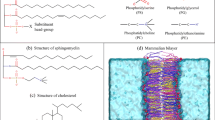Abstract:
Results on the structural and dynamical properties of aqueous solutions of NaPSS (HPSS) are reported. Most samples of previous measurements, including our own, are contaminated by the presence of (temporal) aggregates. The emphasis of this paper lies on investigations of well purified samples at very low ionic strength where interacting effects are maximum. As previously reported, this can be achieved by pumping the suspension through ion exchange resin by means of a tube-pump, using filters of 0.1 μm pore size. Information has been extracted from static and dynamic light scattering and viscosity measurements. A second maximum is observed in the scattering curves versus wavenumber for the first time. It is discussed on the basis of two current models describing the structure of charged macromolecules. The short time dynamics reflects the measured intensity. Detailed viscosity data in comparison of those of rodlike (TMV), slightly flexible so-called fd virus particles (length 880 nm) are used to confirm the interpretation of the light scattering results. The recently observed maximum in the reduced viscosity could be confirmed.
Similar content being viewed by others
Author information
Authors and Affiliations
Additional information
Received: 5 May 1997 / Revised: 1 September 1997 / Accepted: 10 November 1997
Rights and permissions
About this article
Cite this article
Batzill, S., Luxemburger, R., Deike, R. et al. Structural and dynamical properties of aqueous suspensions of NaPSS (HPSS) at very low ionic strength. Eur. Phys. J. B 1, 491–501 (1998). https://doi.org/10.1007/s100510050211
Received:
Issue Date:
DOI: https://doi.org/10.1007/s100510050211




